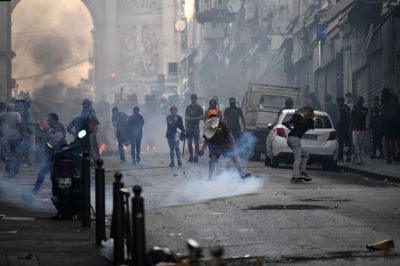Happy Friday! Subway announced this week it will begin serving “freshly sliced meats” in its U.S. restaurants as part of “one of the most complex changes the brand has ever made.”
What … what was in the sandwiches before?
Quick Hits: Today’s Top Stories
- Belarusian President Alexander Lukashenko said yesterday that Yevgeny Prigozhin, the mercenary leader who led a short-lived mutiny against Vladimir Putin last month, had returned to Russia—though neither the Kremlin nor Prigozhin himself have confirmed his location. According to Lukashenko, Prigozhin is “free” in his home country weeks after he was reportedly exiled to Belarus as part of a deal securing immunity for himself and his fighters.
- A U.S. Air Force spokesman said Thursday that Russian jets harassed several American drones in Syrian airspace Wednesday. According to a video released Wednesday night, the Russian aircraft dropped flares in front of the drones, which the U.S. military said were carrying out a mission against targets associated with the Islamic State. Several similar incidents have been reported by the U.S. military—both earlier this week and in recent months.
- The Israeli military shelled a village in southern Lebanon Thursday after two rockets were reportedly fired toward Israel from the area, with one landing in Lebanese territory and the other near disputed land. The attack comes just after the Israeli military’s two-day raid on a West Bank village that killed at least 12 Palestinians whom the Israeli military said were militants.
- Sweden jailed a Kurdish man Thursday for several terrorism-related crimes, signaling the country’s attempts to appease Turkey’s demands that Stockholm crack down on Kurdish separatists. Turkey has been holding up Sweden’s bid to join NATO for months; the two countries’ heads of state will meet next week ahead of a NATO summit at which leaders are expected to discuss Sweden’s potential entry into the alliance.
- A spokesman for the Arizona secretary of state’s office said Wednesday that it recently received a subpoena from special counsel Jack Smith in his investigation into efforts to overturn the 2020 election, including the January 6 attack on the Capitol. Rusty Bowers, the former speaker of Arizona’s state house, also said Wednesday he had been interviewed by the FBI in connection with the probe. The revelations come just days after the Washington Post reported that former President Donald Trump attempted to pressure the state’s governor to overturn election results in late 2020.
- Walt Nauta, a personal aide to Trump, pleaded not guilty Thursday to federal charges related to the mishandling of classified documents at the former president’s Florida estate. Security footage released yesterday showed Nauta, who is accused of conspiring with Trump to illegally retain documents and lying to investigators, moving boxes both before and after the government demanded Trump return the documents.
- The Department of Labor reported Thursday that initial jobless claims—a proxy for layoffs—increased by 12,000 week-over-week to a seasonally-adjusted 248,000 claims last week, and job openings fell from 10.3 million to a two-year low of 9.82 million month-over-month in May, suggesting a softening labor market.
France Rocked by Riots (Again)

A Holocaust memorial defaced. Dozens of public schools set ablaze. A mayor’s wife and children chased from their home. It’s been yet another difficult week in France as the country reels from the fatal police shooting of Nahel Merzouk on June 27. A French-born 17-year-old boy of North African descent, Merzouk was shot and killed by police during a traffic stop in the working-class Parisian suburb of Nanterre. Young people took to the streets in droves shortly thereafter, clashing with police and looting businesses. The violence has finally begun to abate in recent days, but the episode is just the latest flare-up in a year marked by social unrest in France over the country’s trickiest social cleavages, prompting extreme reactions from France’s fractious political elite.
Initial reports of the fatal police shooting suggested Merzouk had attempted to ram into police officers during a traffic stop, causing the officer to fire. That narrative was quickly challenged, however, when a video of the encounter emerged later in the day showing one cop reaching into the stopped vehicle and another with his gun drawn. When Merzouk tried to drive away, the cop pulled the trigger.
The officer who shot Merzouk later said he was trying to keep the teen from fleeing, and feared for his and his partner’s safety if the driver left the scene. That officer has been placed in provisional detention and is being investigated for voluntary homicide, Nanterre’s top prosecutor announced last week. He added that—despite a 2017 law allowing French police to fire at a vehicle fleeing a traffic stop in limited circumstances, including to protect their lives or the lives or others—the officer hadn’t met “legal conditions for the use of the weapon.”
The viral video of the encounter sparked mass rioting, first in Nanterre but quickly in cities across France. Much of the outcry centered on Merzouk’s race, with protesters and rioters suggesting it contributed to the deadly encounter with police. Reuters reported the majority of those killed in the nearly three dozen fatal traffic stops in France since 2017 were either black or of Arab descent. “For years, we’ve been saying that the police are mistreating us, killing us,” one rioter told the New York Times Friday night. “But nobody is listening. Maybe with some riots, they’ll start listening.”
Estimates of the cost of the damage so far have come in at just over $1 billion. French Interior Minister Gérald Darmanin told the French Senate Wednesday rioters set fire to 273 police stations, 168 schools, and 105 town halls. The Finance Minister Bruno Le Maire said at least 1,000 stores had been looted across the country, which is roughly the same size as Texas with a little more than double the state’s population.
Riots are not uncommon in the downtrodden suburbs of Paris, called “banlieues.” Three weeks of violence and unrest devastated the banlieues in 2005, after two teens of African descent were electrocuted during a police chase. “So-called ‘banlieues riots’ have existed in France since the end of the 1970s, but often they took place in the suburbs themselves,” Eric Agrikoliansky, a political science professor at Paris University Dauphine who studies social movements, tells TMD. “Much less often did they target places outside of these poor areas, and especially not town halls, the center of municipal power. It’s definitely new in its breadth and intensity, this targeting of public real estate—these representations of local power and of the police.”
The unrest at home drew French President Emmanuel Macron back to Paris: He cut short a visit to Brussels last Friday for a crisis meeting with members of his government and Saturday delayed a long-planned trip to Germany as the riots continued.
On Saturday, the interior ministry mobilized 45,000 police officers nationally ahead of what they predicted would be a particularly violent night. Rioters in the southern Paris suburb of L’Hay-les-Roses rammed a car into a retaining wall at the mayor’s residence before setting the car on fire. As the mayor’s wife and children, aged 5 and 7, fled the house, the aggressors launched fireworks at them. The attack left one of the children injured and the mayor’s wife with a broken leg requiring surgery. Darmanin said Wednesday that 17 elected officials had been attacked since Merzouk’s shooting.
Even as the violence has abated, the French court system is struggling to keep up with the processing for the more than 3,000 people—many of them teenagers—arrested during the clashes with police. “Very clearly, I want a firm hand,” Justice Minister Éric Dupond-Moretti said Monday. Many courts were holding special weekend sessions and speedy, same-day trials with prosecutors and court-appointed defenders.
The shooting has predictably become a political lightning rod even as the rioting itself is without clear political aims. “Burning down a police station isn’t putting pressure [on the government], it’s not negotiating, it’s not discussion,” Agrikoliansky tells TMD, adding the protestors are poorly organized and lack a clear movement to animate them.
Among the political class, however, the far-left was nearly endorsing the violence, while the far-right used the violence to strike a hard line on law-and-order and immigration. Following the first night of rioting, Jean-Luc Melenchon, leader of the far-left France Unbowed movement, tweeted, “The guard dogs order us to call for calm. We call for justice.” In refusing to condemn the violence, he went too far even for the communists. “I am disassociating myself from the remarks made by Jean-Luc Mélenchon and certain [France Unbowed] members, who refused to call for calm, some going so far as to say that this violence is legitimate, even to the point of justifying it,” Fabien Roussel, the head of the Communist Party, said earlier this week.
Meanwhile, the largest French police union condemned the violence by “vermin” and “violent hordes,” with another saying police were facing a “war.” Jean Messiha, a former spokesperson for the right-wing Reconquête party, started a GoFundMe page for the accused officer, which, at around $1.7 million, has more than tripled the fund started for Merzouk’s family. “The success of this collection is the expression of the cries of the heart of French people who love their police,” he tweeted Wednesday. “It's also an immense outpouring of rage against the hateful chaos that violently dispossesses them of their country every day.” Around 800 police officers have been injured since the beginning of the protests.
Macron and his centrist Renaissance party is trying to split the difference. “Nothing justifies the death of a young person,” Macron said the day after Merzouk’s death. Later that week, he tried to change the subject entirely and lay the blame for the violence at the feet of social media sites like TikTok and WhatsApp. “We’ve seen violent gatherings organized on several [social media platforms]—but also a kind of mimicry of violence,” he said last Friday following his government’s emergency meeting. One adviser in the French executive branch told French paper Le Monde, “If we were only empathetic, we’d be accused of not being firm enough. If we were only indiscriminately repressing, we’d be accused of throwing oil on the fire.”
The atmosphere was more somber than violent Saturday morning, though, as the teen who’d been killed was laid to rest in Nanterre. The mosque hosting the funeral service was filled to capacity, with as many as 200 mourners kneeling in the street at the sound of prayers from inside the mosque.
Sunday morning, Merzouk’s grandmother called for an end to the violence. “The people who are destroying, I tell them to ‘stop,’” she told BFM TV. “They are using Nahel as an excuse. [..] I’m tired. I can’t take it anymore. I can’t sleep. I turned off the TV, I turned everything off. I don’t want to listen to this anymore.”
Picking Putin’s Pocket
It’s a tried-and-true argument any kindergarten teacher will recognize: If we didn’t make the mess, why should we have to clean it up? World leaders are now advancing the same point on the geopolitical stage, weighing how to force Russia to pay for the hundreds of billions of dollars in damage it’s inflicted upon Ukraine in more than a year of full-scale war.
Western leaders kicking around talk of a “Marshall Plan” for Ukraine at various diplomatic summits have come to a consensus that Russia should foot the bill, but there’s not yet any consensus plan for how to make that happen. One obvious solution would be commandeering the roughly $300 billion in Russian money frozen by sanctions in Western banks, but because Europe and the United States aren’t at war with Russia, there’s no real legal mechanism to seize Russian government assets.
That said, there is a process for confiscating sanctioned individuals’ money—it just takes a decent amount of time. “If the government stops some guy on the highway with a whole pile of cash in his car and they think it’s drug money, they can seize it,” Stefan Cassella, a former federal prosecutor and consultant who specializes in asset forfeiture, tells TMD. “But that doesn’t forfeit it. [The government] still has to prove the crime in order to get the title.” The Biden administration has already used this process once, sending Ukraine $5.4 million in forfeited money from an oligarch who violated U.S. sanctions. “While this represents the United States’ first transfer of forfeited Russian funds for the rebuilding of Ukraine,” Attorney General Merrick Garland said back in May, “it will not be the last.”
As lawyers and scholars continue their efforts to pry hundreds of billions of dollars away from the Kremlin and its allies, the war in Ukraine rages on. And as we wrote last month, Russian forces have done significant economic damage. According to the World Bank’s latest calculation in March, the expected cost of recovery in the country totaled roughly $400 billion—and that was long before the Kakhovka Dam was blown up in southern Ukraine.
At the G7 summit in May, the heads of seven advanced, democratic economies agreed in principle they wouldn’t unfreeze any Russian assets until Moscow had paid war reparations. “We reaffirm that, consistent with our respective legal systems, Russia’s sovereign assets in our jurisdictions will remain immobilized until Russia pays for the damage it has caused to Ukraine,” the leaders said in a joint communique. That may be useful leverage, but G7 countries still can’t touch the cash themselves—freezing assets is not the same as officially “forfeiting” them.
Not that world leaders aren’t eager to make use of Russian money in their banks’ coffers. “It’s fundamentally wrong that our taxpayers have to pay for something that we have not caused,” Estonian Prime Minister Kaja Kallas told reporters late last month on the first day of the European Leaders Summit in Brussels. “It should come from Russia’s proceeds—and when we have the assets, we should use them.” The trouble is how, as German Chancellor Olaf Scholz explained: “It’s all terribly complicated, and no one currently knows what’s possible.”
The European Commission has been weighing a couple of options to dispose of the roughly $200 billion in Russian sovereign assets they’ve got lying around in European banks and financial clearinghouses, but as Scholz pointed out, questions of legality have prevented leaders from moving forward with any plan. “We have to respect the principles of international law,” one EU diplomat told CNN. “It’s a matter of reputation, of financial stability and trust.”
One approach that may prove tenable is the so-called “windfall” option: reallocating the European Central Bank’s interest accrued on Russian central bank assets held by European firms. While potentially less lucrative than actively managing the Russian investments and transferring the capital gains, this plan seems preferable to European bureaucrats wary of the legal jeopardy that could come with controlling the assets and the financial risk of losing money on those investments. EU leaders believe the windfall method could generate a little more than $3 billion a year.
European Commission President Ursula Von der Leyen set up a working group to look into the proposal, but the European Central Bank has expressed concern about the plan, arguing it could lead countries with large holdings in Euros to move away from the currency. If the EU levied a windfall tax on Russian assets, what’s to say other countries’ money couldn’t meet the same fate if they run afoul of the bloc’s sanctions?
The legal mechanism for the U.S. government to seize sovereign Russian assets is similarly murky, but the move isn’t entirely without precedent: The Treasury Department did something similar in 2003, taking possession of $1.7 billion in frozen Iraqi assets days after the U.S. and its allies invaded the country. Then-President George W. Bush said the funds would be used to rebuild Iraq after Iraqi leader Saddam Hussein’s regime was toppled. That was a wartime maneuver, though, and there isn’t a clear legal framework to replicate that seizure on a country with whom the U.S. is not at war.
The bipartisan Rebuilding Economic Prosperity and Opportunity (REPO) for Ukrainians Act, introduced last month by Sens. Jim Risch of Idaho and Sheldon Whitehouse of Rhode Island, is an effort to build that framework. “It is only right that frozen Russian government funds be seized and repurposed to help Ukraine rebuild the country Putin has been trying to destroy,” Risch, the top Republican on the Senate Foreign Relations Committee, tells TMD. “My bill will help to do just that, and show our allies there is a legal basis to do what is right with the more than $300 billion worth of Russian assets being held around the globe.”
The legislation, which is yet to be marked up in committee, would enshrine in law the president’s G7 commitment not to release the frozen funds, as well as give the executive branch the authority to confiscate Russia’s sovereign assets and move that seized money into a multilateral fund, designed in concert with allies and partners. It draws on the international law of countermeasures—actions that may not typically be lawful used against a state engaged in an “internationally wrongful” act—to argue the move jives with international law.
The bill’s architects dismissed the fear—already a reality for Finland and Germany—that it could open the U.S. up to similar actions by its enemies. “This bill is focused on the very specific case of the egregious nature of the war in Ukraine, not on setting precedent,” a person familiar with the legislation’s crafting tells TMD. “If we’re talking about Iran taking these measures or countries like Russia taking these measures, these are not countries that we would encourage sovereign investment in anyway.”
Robert Tyler, a senior policy advisor at New Direction, a European think tank, worked on a plan to send Russian assets to an escrow account under similar legal principles as the REPO for Ukrainians Act. “If Congress is able to pass something that looks similar to a model for seizure and transfer,” he tells TMD, “then maybe that will put more pressure on the administration to just do it.”
Worth Your Time
- A mere 2,900 percent over budget and decades behind schedule, the Defense Department is set to destroy the last of the United States’ chemical weapons stockpile as soon as today—the culmination of a process set in motion after the mysterious deaths of 5,600 Utah sheep in 1968 revealed the military’s unsafe storage and testing. After the public opposed the Army’s practice of sinking old chemical weapons at sea, the military developed a multi-step safe disposal process. “At Pueblo, each shell is pierced by a robot arm, and the mustard agent inside is sucked out,” Dave Philipps and John Ismay report for the New York Times. “The shell is washed and baked to destroy any remaining traces. The mustard agent is diluted in hot water, then broken down by bacteria in a process not unlike the one used in sewage treatment plants. It yields a residue that is mostly ordinary table salt, [chemical engineer Walton] Levi, said, but is laced with heavy metals that require handling as hazardous waste.”
Presented Without Comment
NBC News: Tourist Who Etched His and Partner’s Name on Colosseum Says He Didn’t Know It Was Ancient in Apology Letter
Also Presented Without Comment
Wall Street Journal: Don’t Sell Edibles That Look Like Doritos, Federal Officials Tell Companies
Toeing the Company Line
- In the newsletters: Scott explains what’s wrong (🔒) with the talk of “decoupling” from China.
- On the site today: Charlotte covers the Biden administration’s pursuit of a nuclear “understanding” with Iran and Oliver breaks down efforts to outlaw legacy college admissions.
Let Us Know
Were you surprised by France’s latest wave of unrest?








Please note that we at The Dispatch hold ourselves, our work, and our commenters to a higher standard than other places on the internet. We welcome comments that foster genuine debate or discussion—including comments critical of us or our work—but responses that include ad hominem attacks on fellow Dispatch members or are intended to stoke fear and anger may be moderated.
With your membership, you only have the ability to comment on The Morning Dispatch articles. Consider upgrading to join the conversation everywhere.